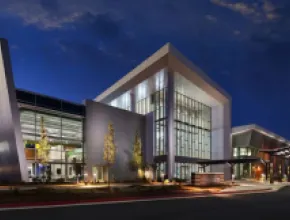Encompassing Raleigh, Durham and Chapel Hill, the Triangle region of North Carolina is well known for its famed research park, top-tier colleges and universities, and fierce sports rivalries. However, more recently, word has spread about the cultural opportunities this trifecta of Southern locales has to offer meeting and event planners.
Raleigh
Raleigh is frequently ranked as one of the top cities in America to live and work due to its central location relative to the East Coast and its abundance of engaging activities, which also makes the city an ideal location for meeting planners to book an event.
There are plenty of great entertainment options within the city, but the music scene has grown especially rapidly. The Greater Raleigh CVB (GRCVB) has even declared Raleigh to be “North Carolina’s Capital of Live Music.”
“We have over 85 live music venues, ranging from the big PNC Arena and Time Warner Cable Music Pavilion, to smaller restaurants and bars that have live music at least three nights a week,” says Ryan Smith, director of communications at the GRCVB. “Pretty much any night of the week, somebody can find live music of any genre.”
While the PNC Arena and The Time Warner Cable Music Pavilion at Walnut Creek continue to bring in big-name, national touring acts such as Sir Paul McCartney, Lady Gaga and Kenny Chesney, the Red Hat Amphitheater has grown into a great midsize venue for concerts and events, recently featuring performances by The Smashing Pumpkins and Imagine Dragons.
“That probably is one of the coolest venues in all of Raleigh, just because it’s right downtown,” Smith says. “It’s always nice to sit outside on the grass when the weather is beautiful and enjoy a show.”
Another concert site that can be utilized for meetings and events is the massive Duke Energy Center for the Performing Arts, which contains four different venues within its walls, such as the large Memorial Auditorium and more intimate Fletcher Opera Theater.
Groups can also take advantage of a number of music festivals in Raleigh, including the annual Hopscotch Music Festival that is held across multiple venues every September and has been called “one of the best and weirdest festivals in America,” by Spin magazine. The festival features a diverse lineup of bands and has been known to draw upward of 60,000 music fans to the area.
Raleigh is also hosting the annual World of Bluegrass Week later in September, culminating with the two-day Wide Open Bluegrass Festival.
“Bluegrass has deep, deep roots in North Carolina because it’s kind of a heritage type music,” Smith says. “A lot of famous bluegrass players come from the state, and it’s really kind of interwoven into the fabric of North Carolina music.” PageBreak
Durham
The food scene in Durham has been one of North Carolina’s best-kept secrets, dating back to the opening of Bullock’s Bar-B-Cue in 1952. The family-owned and -operated business still dishes out its classic home-cooked meals to visitors and is the oldest continuous-running restaurant in the area.
Nearly 62 years later, the dining scene has exploded in Durham, which offers more than 700 restaurants for meeting attendees to explore (and that’s not counting the 50-plus food trucks operating within the city at any given time, which are chef-driven and known to provide quality food).
“You want to go to the tastiest town in the South?” asks Sam Poley, director of public relations and communications at the Durham CVB (DCVB). “Don’t go to New Orleans, don’t go to Austin or Charleston, and forget Miami—go to Durham.”
Foodies from outside of North Carolina may scoff at Poley’s statement, but Durham has the media attention to back up his claim. In the past year alone, The New York Times has written two full-length articles on the city as an emerging food destination, and in April, Durham was named Southern Living’s “Tastiest Town in the South,” which saw the city trending on Twitter under the hashtag #DurhamIsTastiest.
“The food scene here is incredible and it continues to draw people from outside the market, from other communities, from other states across the country. People are coming to be a part of this and check it out,” Poley says. “Durham is definitely worth your time and attention.”
When attendees are not spending time at popular meeting spots, such as the recently renovated, 44,000-square-foot Durham Convention Center or the scenic Museum of Life and Science, they can relax and enjoy a variety of foods ranging from traditional Southern home-cooked favorites to the finest of French cuisine.
“If you were going to do something in the convention center, you could probably organize a mini food truck rodeo with no difficulty at all,” Poley says. “And that’s totally fine with people who are attending meetings. They love to see stuff like that.”
Poley notes the DCVB has a categorization system on the “Celebrated Cuisine” section of its website to help people track down some of the local restaurants that have received multistate or national media attention.
One of these local favorites is Taqueria La Vaquita, which serves authentic Mexican food out of an old orange building with yellow trim and a massive cow on its roof. It is located about five minutes from the Duke University campus. The cow has become such a popular symbol among residents that when it got damaged by bad weather and was going to be removed, they actually raised money to save it.
Those who are looking for more of a fine-dining experience should check out Nana’s, which remains one of the most popular restaurants in the Triangle region and features an extensive wine list and world-class cuisine. PageBreak
Chapel Hill
Chapel Hill is situated in Orange County on the western edge of the Triangle region and has a reputation for having an “edgy” feel, so the Chapel Hill and Orange County Visitors Bureau (CHVB) naturally worked this into the town’s new “Edge of the Triangle” marketing campaign.
“We want some of the millions of people who come to the Triangle to consider Chapel Hill for their next meeting location,” says Patty Griffin, director of communications at the CHVB. “Or for those meeting or visiting other parts of the Triangle, extend their stay an extra day or two.”
The town of Chapel Hill may not be as large as Raleigh or Durham, but it’s still within 25 minutes of Raleigh-Durham International Airport, making it easy to get to. Where Raleigh has a booming music scene and Durham a strong food culture, Chapel Hill seems to specialize in no singular area, but instead uses its small-town charm to provide a little bit of everything.
Chapel Hill was named “America’s Foodiest Small Town” (alongside Durham) back in 2008 by Bon Appetit magazine and still lives up to the title. Several Orange County chefs have even been honored with the James Beard Award.
Crook’s Corner restaurant was named an “American Classic” by the James Beard Foundation in 2011. And in 2013, Lantern was a semi-finalist for “Outstanding Restaurant.”
“Our restaurants offer Italian, Indian, Ethiopian, Cajun and French, and good old Southern-style cooking, providing our visitors with options for any palate,” says Linda Ekeland, director of sales for the CHVB.
Chapel Hill, much like Raleigh and Durham, takes pride in its local dining options and is a strong proponent of the farm-to-fork movement.
A local favorite among food and beverage enthusiasts is Top of the Hill Restaurant, Brewery and Distillery, which accommodates groups in its Great Room Complex. Hosting up to 220 people seated and up to 300 standing, the complex is the only large-scale event space located directly on Franklin Street, a popular thoroughfare in town.
At Top of the Hill Distillery, small-batch vodka, whiskey and gin are created from scratch, using organic Carolina wheat and botanicals that are distilled in a copper pot and columns from a fifth-generation German still maker.
The distillery and brewery offer group tours and tastings.
Aside from its small-town charm, Chapel Hill features several options for small to midsize meetings, from AAA Four Diamond offerings to boutique and funky properties.







